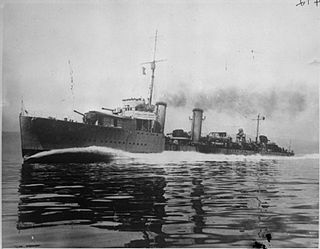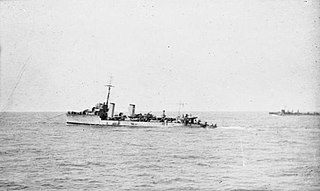
The first HMS Montrose was one of eight Admiralty-type destroyer leaders, sometimes known as the Scott class. They were named after figures from Scottish history; Montrose was named for the Graham Dukes of Montrose. She was built during the First World War, but was completed too late for service then. However, she had a long career in the inter-war years and saw extensive service during the Second World War.
HMS Sceptre was an R-class destroyer of the Royal Navy, built by Alexander Stephen and Sons, at Linthouse and launched on 18 April 1917. In total 51 ships were in this class and saw service in World War I, entering service from 1916 to 1917 and suffering comparatively light losses. Sceptre saw action as part of the Harwich Force, operating mainly in the North Sea. She survived the war and was sold for disposal in 1926.

The S class was a class of 67 destroyers ordered for the Royal Navy in 1917 under the 11th and 12th Emergency War Programmes. They saw active service in the last months of the First World War and in the Russian and Irish Civil Wars during the early 1920s. Most were relegated to the reserve by the mid-1920s and subsequently scrapped under the terms of the London Naval Treaty. Eleven survivors saw much action during the Second World War.

HMS Valkyrie was a First World War V-class flotilla leader of the Royal Navy. She was one of two destroyers ordered in July of 1916 from William Denny & Bros. Ltd shipyard under the 9th Order for Destroyers of the Emergency War Program of 1916–17. She was originally to be called HMS Malcolm but was renamed before being completed. The name Malcolm was later assigned to another destroyer leader.

HMS Meteor was a Thornycroft M-class destroyer that served in the British Royal Navy. Meteor saw extensive service throughout World War I, maintaining continuous operations both as a convoy escort and in harbour protection.

The fifth HMS Valorous, ex-HMS Montrose, was a V-class flotilla leader of the British Royal Navy that saw service in World War I, the Russian Civil War, and World War II.

HMS Abdiel was a Marksman-class flotilla leader of the Royal Navy, built by Cammell Laird during the First World War. She was converted to a minelayer during construction, commissioning during 1916, and served at the Battle of Jutland. Following the end of the war, Abdiel served in the Baltic during the Russian Civil War. She was sold for scrap in 1936.

HMS Bruce was the second of eight Admiralty type flotilla leaders of the Royal Navy. Built by Cammell Laird, Bruce was commissioned on 29 May 1918. During the First World War, she served with the 10th Destroyer Flotilla at Harwich. After the end of the war, Bruce spent several years in reserve at British ports, before spending almost 10 years based on the China Station. She was withdrawn from use because of her poor condition, and was sunk as a target ship on 22 November 1939.
HMS Laverock was a Laforey-class destroyer of the Royal Navy. She was launched in 1913 and entered service in October 1914. Laverock served through the First World War, operating with the Harwich Force and in the English Channel. She was sold for scrap in 1921.

HMS Mackay was an Admiralty type, sometimes known as the Scott class, flotilla leader of the British Royal Navy. Mackay was built by Cammell Laird during the First World War, but was completed too late for service then, commissioning in 1919.
HMS Murray was a Royal Navy Admiralty M-class destroyer. Ordered before the outbreak of war, she was therefore the first of her class to enter operation during the early months of the First World War. She was also the first vessel of the Royal Navy to carry the name HMS Murray.

HMS Nimrod was a Marksman-class flotilla leader of the British Royal Navy. She was built by the Scottish shipbuilder Denny, with construction starting in 1914 and completed in August 1915. She served through the remainder of the First World War. She was sold for scrap in 1921.
HMS Lightfoot was a Marksman-class flotilla leader of the British Royal Navy. Construction by J. Samuel White began in June 1914, shortly before the outbreak of the First World War, and the ship was launched and completed in 1915. She survived the war and was sold for scrap in 1921.

HMS Taurus was an R-class destroyer which served with the Royal Navy during World War I. Ordered from Thornycroft in 1915 and launched in 1917, the vessel operated as part of the Harwich Force until the end of hostilities. Shortly after entering service, Taurus formed part of the destroyer shield for the Royal Navy's bombardment of Ostend that successfully sank the German destroyer S20. After the War, the destroyer was reduced to reserve and scrapped in 1930.

HMS Rob Roy was a Royal Navy R-class destroyer constructed and then operational in the First World War. The ship served in the Grand Fleet as part of the Fifteenth Destroyer Flotilla.

HMS Retriever was a Thornycroft-built R-class destroyer which served with the Royal Navy during the First World War. Launched on 15 January 1917, the vessel formed part of the Harwich Force and took part in operations off the coast of Ostend in support of the bombardment of the town in June that year. During August the following year, the vessel attempted to deploy a seaplane from a towed lighter, but a lack of wind meant the operation was unsuccessful. The vessel was also jointly credited with the destruction of the submarine SM UB-54 that year, although this has been disputed. After the war, the ship was placed in reserve and was sold to be broken up on 26 July 1927.
HMS Lark was a Laforey-class destroyer of the British Royal Navy. The Laforey class was the class of destroyers ordered under the Royal Navy's 1912–1913 construction programme, which were armed with three 4-inch (102 mm) guns and four torpedo tubes and were capable of 29 knots. The ship, which was originally to be named Haughty but was renamed before launch, was built by the Scottish shipbuilder Yarrow between 1912 and 1913.
HMS Grenville was a Parker-class flotilla leader of the British Royal Navy. She was built by Cammell Laird during the First World War, being launched on 17 June 1916 and completing on 11 October that year. Grenville served with the Grand Fleet for the rest of the war, which she survived. The ship took part in operations in the Baltic during the Russian Civil War in the winter of 1919–1920, before entering a long period of reserve. She was sold for scrap in December 1931.

HMS Shakespeare was a Thornycroft type flotilla leader of the British Royal Navy. She was built by J I Thornycroft from 1916 to 1917 as the lead ship of her class, launching in July 1917 and completing in October 1917.

HMS Wallace was a Thornycroft type flotilla leader of the British Royal Navy. Built by J I Thornycroft during the First World War, Wallace was launched on 26 October 1918, and completed in February 1919, after the end of the war.














